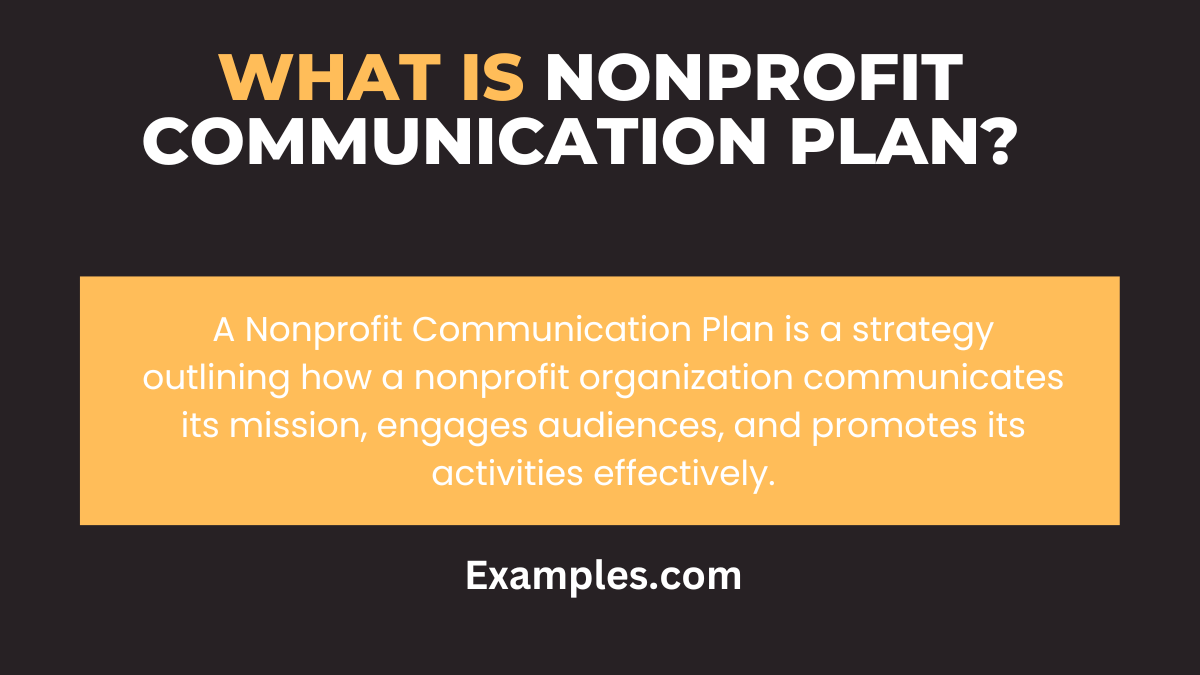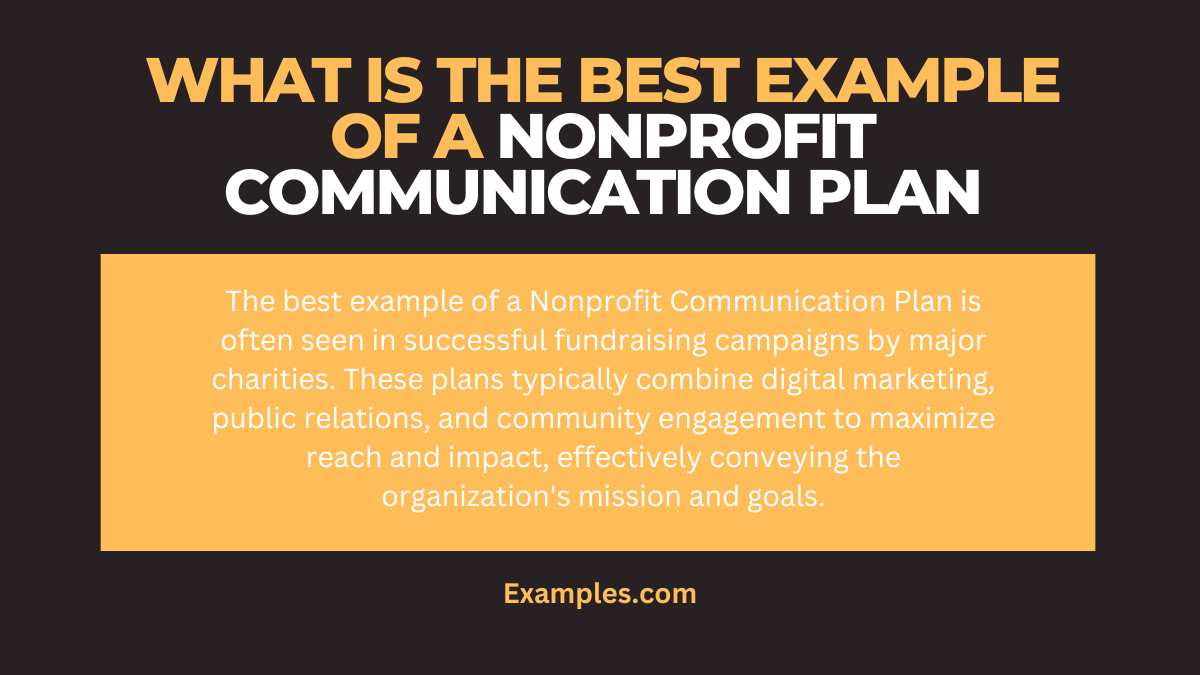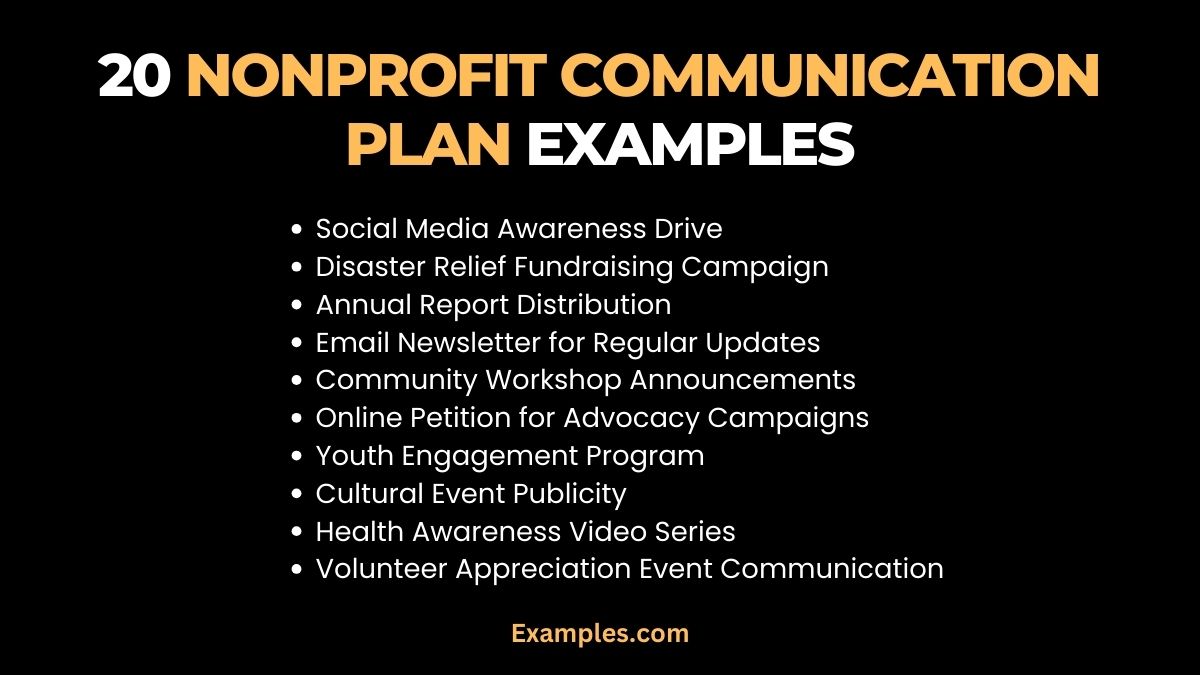19+ Nonprofit Communication Plan Examples
Creating an effective nonprofit communication plan is essential for organizations seeking to make a meaningful impact. In this comprehensive guide, we’ll delve into the intricacies of nonprofit communication, providing you with valuable insights, strategies, and communication examples. Whether you’re aiming to engage donors, mobilize volunteers, or raise awareness for your cause, crafting a well-structured communication plan is the key to success. Join us as we explore the steps, tips, and real-world communication examples to help your nonprofit thrive in today’s dynamic landscape.
What is Nonprofit Communication Plan? – Meaning

A Nonprofit Communication Plan is a strategic guide used by nonprofit organizations to effectively communicate their mission, goals, and activities. It outlines how to share information with the public, donors, volunteers, and other stakeholders. The plan includes methods for using different channels like social media, newsletters, and press releases to spread their message, engage the community, and support fundraising efforts. Essentially, it’s a roadmap for how a nonprofit talks about its work and interacts with its audience.
Best Example of a Nonprofit Communication Plan

Nonprofit Communication Plan is often seen in large-scale fundraising campaigns by major nonprofit organizations. Such a plan typically involves a multi-channel approach, combining social media, email newsletters, press releases, and community events to engage a wide range of stakeholders. It aims to raise awareness, generate funds, and mobilize volunteers, all aligned with the organization’s mission.
20 Nonprofit Communication Plan Examples

Nonprofit organizations rely on effective communication plan to fulfill their missions. They encompass a range of activities from fundraising to awareness campaigns, each tailored to specific goals and audiences, ensuring impactful and meaningful communication.
- Social Media Awareness Drive:
- Cause: Low public engagement.
- Fix: Regular, engaging posts on social platforms.
- Disaster Relief Fundraising Campaign:
- Cause: Immediate funding need for disaster response.
- Fix: Urgent appeal through multiple channels for donations.
- Annual Report Distribution:
- Cause: Transparency in operations.
- Fix: Digital and print reports detailing yearly accomplishments.
- Email Newsletter for Regular Updates:
- Cause: Consistent donor and volunteer engagement.
- Fix: Monthly newsletters with updates and stories.
- Community Workshop Announcements:
- Cause: Promoting educational initiatives.
- Fix: Local advertising and social media promotion.
- Online Petition for Advocacy Campaigns:
- Cause: Mobilizing support for a cause.
- Fix: Digital campaigns for petition signing and sharing.
- Youth Engagement Program:
- Cause: Involving younger demographics.
- Fix: Targeted programs and communication for youth.
- Cultural Event Publicity:
- Cause: Community cultural engagement.
- Fix: Local media outreach and online event pages.
- Health Awareness Video Series:
- Cause: Spreading health-related information.
- Fix: Educational videos shared via YouTube and website.
- Volunteer Appreciation Event Communication:
- Cause: Recognizing volunteer efforts.
- Fix: Invitations and public acknowledgments on various platforms.
- Online Fundraising Auction:
- Cause: Diversifying fundraising methods.
- Fix: Host an online auction with donated items.
- Environmental Conservation Campaign:
- Cause: Raising awareness about environmental issues.
- Fix: Social media campaigns and local community events.
- Board Member Recruitment Drive:
- Cause: Expanding organizational leadership.
- Fix: Targeted networking and LinkedIn outreach.
- Volunteer Training Webinars:
- Cause: Enhancing volunteer skills and knowledge.
- Fix: Regular online training sessions.
- Annual Charity Gala Announcement:
- Cause: Major fundraising event promotion.
- Fix: Utilize email blasts and local media partnerships.
- Crowdfunding for Specific Projects:
- Cause: Funding for targeted initiatives.
- Fix: Launch a crowdfunding campaign with compelling storytelling.
- Newsletter Featuring Success Stories:
- Cause: Showcasing impact to donors and supporters.
- Fix: Share beneficiary stories in a monthly newsletter.
- Interactive Social Media Q&A Sessions:
- Cause: Increasing engagement on social platforms.
- Fix: Host live Q&A sessions on social media.
- Collaboration Announcements with Other NGOs:
- Cause: Building partnerships for broader impact.
- Fix: Joint press releases and social media posts.
- Special Day Campaigns (e.g., World Health Day):
- Cause: Aligning with global awareness days.
- Fix: Campaigns themed around these days, leveraging global attention.
Marketing Communication Plan for Nonprofit Organization
A marketing communication plan for a nonprofit organization is a strategic blueprint focusing on promoting the organization’s mission, increasing awareness, and driving engagement. It integrates various marketing tools to reach a wider audience effectively.
- Email Campaign for Donor Engagement: Regular updates to donors about ongoing projects.
Example: “See the impact of your contribution in our latest project highlights.” - Social Media Advocacy: Utilizing platforms like Facebook and Twitter to spread awareness.
Example: “Join us in our mission by sharing our story on your social media.” - Influencer Collaborations: Partnering with influencers to reach a broader audience.
Example: “Excited to collaborate with [Influencer] to bring attention to our cause.”
Crisis Communication Plan Nonprofit
A crisis communication plan for a nonprofit organization is essential for effectively managing unexpected situations. It outlines the steps to communicate during emergencies, maintaining transparency and trust.
- Natural Disaster Response: Immediate communication in the event of natural disasters.
Example: “We are actively responding to the recent earthquake, here’s how you can help.” - Handling Negative Publicity: Addressing any negative press or public opinion.
Example: “We are committed to transparency and want to address recent concerns publicly.” - Data Breach Notification: Informing stakeholders about any security incidents.
Example: “We’re taking immediate steps to secure our systems after the recent data breach.”
Communication Plan for Nonprofit Organizations
A communication plan for nonprofit organizations lays out a structured approach for conveying the organization’s message, engaging with the community, and supporting its goals.
-
- Community Outreach Programs:Initiatives to connect and collaborate with the local community.
Example: “Join us at our community center for a series of educational workshops.” - Donor Appreciation Events:Recognizing and thanking donors.
Example: “We’d like to invite our donors to an evening of appreciation for your continued support.” - Volunteer Recruitment Campaign: Strategies to attract and retain volunteers.
Example: “Become a part of our team and make a difference – volunteer with us today
- Community Outreach Programs:Initiatives to connect and collaborate with the local community.
How do You Write a Nonprofit Communication Plan?
Writing a nonprofit communication plan involves a strategic and thoughtful process:
- Define Your Objectives: Clearly state what you want to achieve with your communication efforts. This could be raising awareness, increasing donations, or recruiting volunteers.
- Understand Your Audience: Identify who you need to communicate with. This might include donors, volunteers, the media, and the public.
- Message Development: Craft key messages that align with your objectives and resonate with your audience.
- Choose Communication Channels: Select the most effective channels to reach your audience, such as social media, email newsletters, or press releases.
- Create a Timeline: Develop a schedule for your communication channels. This should include regular updates and time-bound campaigns.
- Allocate Resources: Determine the resources needed, including staff and budget.
- Implement and Monitor: Execute your plan and continuously monitor its effectiveness, making adjustments as needed.
- Feedback and Evaluation: Regularly gather feedback from your audience and evaluate the success of your communication strategies.
How To Build a Nonprofit Communication Plan Strategy?
Building a Nonprofit Communication Plan Strategy involves several key steps:
- Define Your Objectives: Clearly outline what you want to achieve with your objective communication efforts, such as raising awareness, increasing donations, or engaging volunteers.
- Understand Your Audience: Identify and understand your target audience, including their preferences and communication channels they use most.
- Develop Key Messages: Craft messages that resonate with your audience and reflect your nonprofit’s goals and values.
- Choose the Right Channels: Select appropriate communication channels (e.g., social media, email, events) to reach your audience effectively.
- Create a Content Calendar: Plan and schedule your internal communication activities to maintain consistency and relevance.
- Implement and Monitor: Execute your plan and continuously monitor its effectiveness, making adjustments as needed.
- Evaluate and Adapt: Regularly assess the impact of your communication strategy and adapt it to changing needs and insights.
What are the Components of a Nonprofit Communication Plan?
A Nonprofit Communication Plan typically includes clear objectives, target audience identification, key messages, chosen communication channels, a detailed implementation timeline, resource allocation, monitoring and evaluation methods, and feedback mechanisms for continuous improvement.
What are the Best Nonprofit Communication Strategies
Effective nonprofit communication strategies include storytelling to connect emotionally, utilizing social media for broader reach, engaging in community outreach, developing email marketing campaigns, and maintaining transparent and consistent communication with donors and volunteers. These strategies are key to building trust and fostering long-term relationships.
A well-crafted nonprofit communication plan is the cornerstone of success for any organization dedicated to making a positive impact on the world. By aligning your goals, audience insights, and messaging strategies, you can effectively engage with your supporters, donors, and stakeholders. Consistency and authenticity in your communication efforts are key. It’s not just about conveying your mission; it’s about building lasting relationships and inspiring action.
As you continue to refine your nonprofit communication plan, consider exploring additional resources from authoritative sources in the field. For more in-depth insights into nonprofit communications strategies, to gain a comprehensive understanding of communications planning, we recommend reading the insightful article “Nonprofit Communications Planning : What Every Nonprofit Needs to Know” on the Funraise blog.



